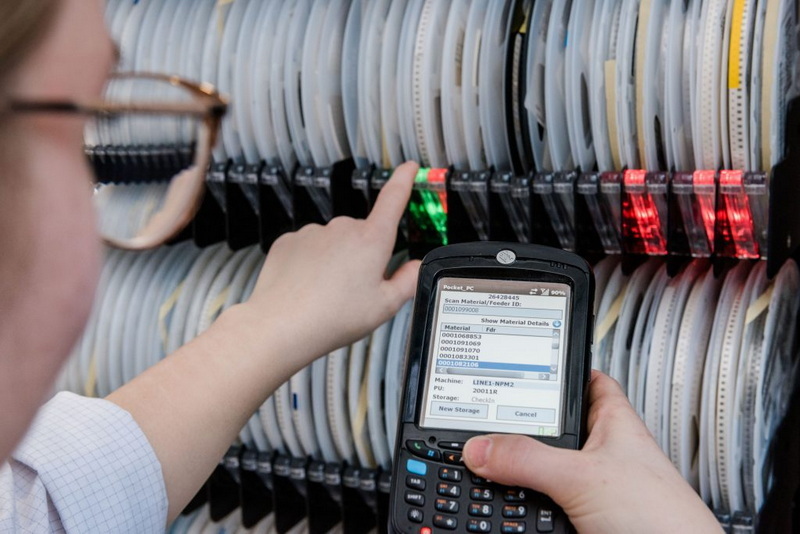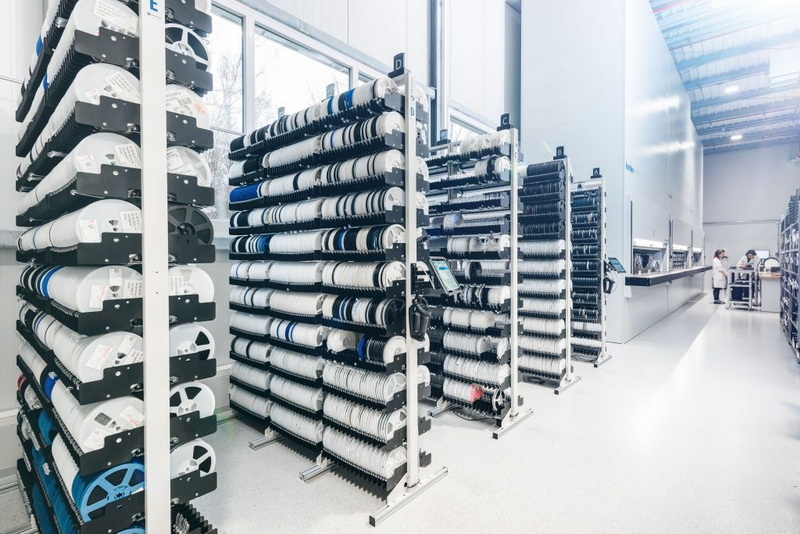Content Menu
● Introduction to the SMT Reel Storage Market
>> Market Overview
● Major Challenges in the SMT Reel Storage Market
>> 1. Space Constraints and Scalability Issues
>> 2. High Costs of Automation and ROI Uncertainty
>> 3. Managing Component Diversity and Traceability
>> 4. Environmental and Electrostatic Risks
>> 5. Integration with Smart Factory Ecosystems
● Emerging Trends in the SMT Reel Storage Market
>> 1. AI-Driven Predictive Inventory Management
>> 2. Modular and Mobile Storage Units
>> 3. Sustainable Material Innovations
>> 4. Digital Twin Integration
● Solutions to Overcome Challenges
>> 1. Hybrid Automation Systems
>> 2. Cloud-Based Inventory Platforms
>> 3. ESD and Climate Control Innovations
>> 4. Collaborative Robotics (Cobots)
● Conclusion
● FAQs
>> 1. How does component miniaturization impact the SMT reel storage market?
>> 2. What role do RFID tags play in SMT reel storage?
>> 3. Can small manufacturers afford automated storage solutions?
>> 4. How do climate-controlled storage units improve production yield?
>> 5. What are the cybersecurity risks in IoT-enabled SMT storage systems?
The SMT (Surface Mount Technology) reel storage market is a cornerstone of modern electronics manufacturing, enabling the efficient organization and deployment of components critical to producing devices like smartphones, medical equipment, and automotive systems. However, as demand for miniaturized, high-performance electronics grows, the industry faces significant challenges in optimizing storage solutions. This article delves into the complexities of the SMT reel storage market, exploring its hurdles, innovations, and strategies for overcoming obstacles while maintaining competitiveness.

Introduction to the SMT Reel Storage Market
The SMT reel storage market supports the backbone of electronics assembly by managing reels that house surface-mount components such as resistors, capacitors, and integrated circuits (ICs). These reels feed pick-and-place machines, which populate PCBs at high speeds. With the rise of smart factories and IoT-driven production, the need for precise, scalable, and reliable storage systems has never been greater.
Market Overview
- Market Valuation: Valued at $0.74 billion in 2023, the SMT reel storage market is projected to reach $1.2 billion by 2032, growing at a CAGR of 5.48% (Allied Market Research).
- Key Drivers:
- Miniaturization of electronic components requiring precise handling.
- Adoption of Industry 4.0 and automated production lines.
- Expansion of 5G, automotive electronics, and wearable technology sectors.
Major Challenges in the SMT Reel Storage Market
1. Space Constraints and Scalability Issues
Modern electronics manufacturing facilities often operate in high-density environments where floor space is limited. Traditional horizontal shelving systems struggle to accommodate the growing variety of SMT reels, which can range from 7-inch to 15-inch diameters. For example, a mid-sized facility storing 10,000 reels may require over 500 square meters of space using conventional methods. Vertical storage solutions, such as automated towers, reduce footprint by up to 70% but require significant upfront investment.
Keyword Integration: The SMT reel storage market increasingly prioritizes vertical solutions to address spatial limitations in high-volume production environments.
2. High Costs of Automation and ROI Uncertainty
While fully automated SMT reel storage systems reduce human error and improve retrieval speeds, their implementation costs can exceed $500,000 for large-scale setups. Robotic arms, conveyor belts, and IoT-enabled tracking systems contribute to these expenses. Smaller manufacturers often face difficulty justifying the ROI, especially when production volumes fluctuate. Semi-automatic systems, costing 30-50% less, offer a middle ground by combining barcode scanners and LED-guided picking.
Case Study: A Japanese automotive electronics supplier reported a 22% reduction in mispick errors after adopting semi-automatic smart shelves, achieving ROI within 18 months.
3. Managing Component Diversity and Traceability
A single production line may handle over 500 unique component types, each requiring specific storage conditions. For instance, moisture-sensitive components (MSDs) like BGAs must be stored at ≤10% relative humidity, while ESD-sensitive parts need shielded environments. Manual tracking increases the risk of cross-contamination or expiration. Advanced warehouse management systems (WMS) with RFID tagging now enable real-time traceability, but retrofitting legacy systems remains a hurdle.
Keyword Integration: Traceability solutions are reshaping the SMT reel storage market by integrating RFID and blockchain for component lifecycle management.
4. Environmental and Electrostatic Risks
ESD damage accounts for 8-12% of component losses in unshielded storage systems (IPC Standards). Humidity fluctuations can also degrade solder paste performance. To mitigate these risks, manufacturers must invest in ESD-safe polymer shelves ($200-$500 per unit) and climate-controlled rooms, which add $10,000-$50,000 annually in energy costs. However, neglecting these measures risks costly production halts due to defective components.
5. Integration with Smart Factory Ecosystems
Industry 4.0 demands seamless data flow between SMT reel storage systems and MRP/ERP platforms. Many legacy storage units lack APIs for integration, creating silos. For example, a German industrial IoT report found that 68% of manufacturers struggle to connect storage inventory data with predictive maintenance tools. Retrofitting older systems with IoT gateways ($1,500-$5,000 per unit) is a common but expensive fix.

Emerging Trends in the SMT Reel Storage Market
1. AI-Driven Predictive Inventory Management
Machine learning algorithms analyze historical production data to forecast reel usage patterns, reducing overstocking by up to 35%. Companies like Siemens have deployed AI models that predict reel replenishment needs with 92% accuracy, slashing downtime.
2. Modular and Mobile Storage Units
Modular systems, such as interchangeable cartridge-based designs, allow manufacturers to reconfigure storage layouts in under 30 minutes. Mobile robotic shelving units, which bring reels directly to production stations, are gaining traction in JIT (Just-in-Time) environments.
3. Sustainable Material Innovations
Recyclable polymer composites now replace traditional metal shelving, cutting carbon footprints by 40%. Companies like Myers Industries have introduced ESD-safe shelves made from 80% recycled plastics, aligning with EU circular economy mandates.
4. Digital Twin Integration
Digital twins simulate storage system performance under varying production scenarios. For instance, Texas Instruments reduced warehouse congestion by 27% after testing layout changes virtually before implementation.
Solutions to Overcome Challenges
1. Hybrid Automation Systems
Combining automated vertical carousels for high-usage reels with manual shelves for low-turnover items balances cost and efficiency. This approach cuts initial investment by 25-40% while maintaining 99% inventory accuracy.
2. Cloud-Based Inventory Platforms
Cloud WMS solutions like Fishbowl or SAP EWM provide real-time visibility across multiple facilities. These platforms use predictive analytics to optimize reel rotation and reduce obsolescence.
3. ESD and Climate Control Innovations
New passive ESD materials, such as carbon-fiber-infused polymers, eliminate the need for active grounding systems. Desiccant-free dry cabinets using nitrogen purging now maintain humidity at 5% with 30% lower energy use.
4. Collaborative Robotics (Cobots)
Cobots like Universal Robots' UR10 can retrieve reels from heights exceeding 4 meters, working alongside human operators to reduce physical strain and errors.
Conclusion
The SMT reel storage market is navigating a transformative phase marked by technological advancements and escalating operational demands. Challenges like spatial constraints, automation costs, and environmental risks persist, but innovations in AI, modular design, and sustainable materials are paving the way for resilient solutions. As the electronics industry continues to evolve, stakeholders must prioritize adaptability and integration with smart manufacturing ecosystems to maintain a competitive edge.

FAQs
1. How does component miniaturization impact the SMT reel storage market?
Miniaturization requires storage systems to accommodate smaller reel sizes while maintaining precise handling mechanisms to avoid component damage.
2. What role do RFID tags play in SMT reel storage?
RFID tags enable real-time tracking of reel location, expiration dates, and usage history, reducing manual inventory checks by 90%.
3. Can small manufacturers afford automated storage solutions?
Yes, scalable semi-automatic systems with pay-as-you-grow models allow smaller players to adopt automation incrementally.
4. How do climate-controlled storage units improve production yield?
They prevent moisture absorption and oxidation in components, ensuring solderability and reducing defect rates by up to 15%.
5. What are the cybersecurity risks in IoT-enabled SMT storage systems?
Unsecured IoT devices can expose production data to breaches. Implementing encrypted communication protocols and regular firmware updates mitigates these risks.




















